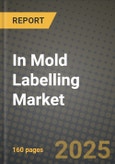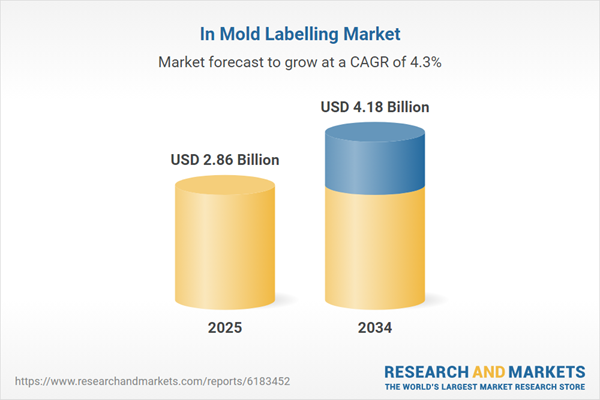In Mold Labelling Market
The In-Mold Labelling (IML) Market integrates printed plastic films with injection, blow-moulding, or thermoforming so decoration becomes part of the container wall, delivering premium aesthetics, abrasion resistance, and mono-material recyclability. Core applications include dairy/ice-cream tubs and lids, ready-meal and confectionery packs, household and industrial pails (paints, lubes, chemicals), personal care containers, closures/caps, logistics crates, and horticulture pots. Converters balance cycle time, label handling, and part geometry to hit high OEE on thin-wall packaging while meeting branding demands for matte/soft-touch, metallic, high-gloss, tactile, and photo-real finishes. Trends include hybrid print workflows (offset/flexo/digital) for shorter runs and personalization; advanced PP label stocks (ultra-clear, cavitated white, tactile lacquers); static-assisted robot placement with vision QC; and design-for-recycling that aligns label/polymer with mono-material PP or PE containers. Drivers span brand premiumization versus shrink-sleeve/PSL, circularity and EPR pressures favouring delabel-free recycling, spoilage-resistant graphics for cold-chain condensation, and factory automation that compresses changeovers. The competitive landscape features integrated moulders-label printers, label-film producers, ink/varnish specialists, automation/robotics suppliers, and injection/blow OEMs. Barriers include upfront mould/automation capex, label sourcing lead times, mould wear and warpage risk on aggressive geometries, and cycle-time sensitivities when adding barrier layers or complex effects. Overall, IML is shifting from niche decoration to a scalable, sustainability-aligned platform that couples high-impact branding with line efficiency and end-of-life compatibility.In Mold Labelling Market Key Insights
- Mono-material circularity advantage
- Automation and OEE are decisive
- Print technology convergence
- Aesthetics with durability
- Cost and tooling economics
- Beyond tubs and pails
- Design-for-IML engineering
- Sustainability and EPR alignment
- Barrier and functional IML (selective)
- Supply-chain resilience as a moat
In Mold Labelling Market Reginal Analysis
North America
Adoption anchored in dairy, ice-cream, and household/industrial pails, with strong emphasis on thin-wall efficiency and robotics. Retailer recyclability criteria favour PP-on-PP IML. Reshoring and line automation drive integrated moulder-printer models; digital adds SKU agility for private labels.Europe
Leading region for IML with stringent circular-economy rules and design-for-recycling guidance. Brands deploy matte/soft-touch and premium effects on mono-material packs; digital watermarks/DPP pilots advance. High tooling quality, fast cavitation, and low-migration inks are baseline expectations.Asia-Pacific
Rapid growth across dairy, confectionery, instant foods, and paints/pails. Local machine/robot ecosystems scale cost-effective cells; capex sensitivity encourages phased automation. Material availability and label conversion capacity are expanding, with increasing interest in rPP and food-safe ink systems.Middle East & Africa
IML gains in paints/lubes pails, dairy, and premium FMCG. Hot-climate durability and UV stability guide ink/varnish specs; regional hubs invest in integrated moulder-label lines. Logistics crates and closures see rising use for ruggedization and anti-scuff branding.South & Central America
Dairy/frozen desserts and agro-chem pails drive demand; converters prioritize robust labels for cold-chain and rough handling. Cost management steers toward high-efficiency moulds and regional label printing; recyclability and mono-material specs grow with retailer programs.In Mold Labelling Market Segmentation
By Technology
- Injection molding
- Blow molding
- Thermoforming
By End-User
- Food
- Beverage
- Cosmetics
- Household Care
- Pharmaceuticals
- Others
Key Market players
Multi-Color Corporation (MCC Verstraete), CCL Industries (CCL Label), Constantia Flexibles, Coveris, Korsini (Korsini-SAF), Inland Packaging, Spektar IML, Taghleef Industries, Jindal Films, Innovia Films, Yupo Corporation, UFlex, Greiner Packaging, Berry Global (Superfos), Gizeh VerpackungenIn Mold Labelling Market Analytics
The report employs rigorous tools, including Porter’s Five Forces, value chain mapping, and scenario-based modelling, to assess supply-demand dynamics. Cross-sector influences from parent, derived, and substitute markets are evaluated to identify risks and opportunities. Trade and pricing analytics provide an up-to-date view of international flows, including leading exporters, importers, and regional price trends.Macroeconomic indicators, policy frameworks such as carbon pricing and energy security strategies, and evolving consumer behaviour are considered in forecasting scenarios. Recent deal flows, partnerships, and technology innovations are incorporated to assess their impact on future market performance.
In Mold Labelling Market Competitive Intelligence
The competitive landscape is mapped through proprietary frameworks, profiling leading companies with details on business models, product portfolios, financial performance, and strategic initiatives. Key developments such as mergers & acquisitions, technology collaborations, investment inflows, and regional expansions are analyzed for their competitive impact. The report also identifies emerging players and innovative startups contributing to market disruption.Regional insights highlight the most promising investment destinations, regulatory landscapes, and evolving partnerships across energy and industrial corridors.
Countries Covered
- North America - In Mold Labelling market data and outlook to 2034
- United States
- Canada
- Mexico
- Europe - In Mold Labelling market data and outlook to 2034
- Germany
- United Kingdom
- France
- Italy
- Spain
- BeNeLux
- Russia
- Sweden
- Asia-Pacific - In Mold Labelling market data and outlook to 2034
- China
- Japan
- India
- South Korea
- Australia
- Indonesia
- Malaysia
- Vietnam
- Middle East and Africa - In Mold Labelling market data and outlook to 2034
- Saudi Arabia
- South Africa
- Iran
- UAE
- Egypt
- South and Central America - In Mold Labelling market data and outlook to 2034
- Brazil
- Argentina
- Chile
- Peru
Research Methodology
This study combines primary inputs from industry experts across the In Mold Labelling value chain with secondary data from associations, government publications, trade databases, and company disclosures. Proprietary modeling techniques, including data triangulation, statistical correlation, and scenario planning, are applied to deliver reliable market sizing and forecasting.Key Questions Addressed
- What is the current and forecast market size of the In Mold Labelling industry at global, regional, and country levels?
- Which types, applications, and technologies present the highest growth potential?
- How are supply chains adapting to geopolitical and economic shocks?
- What role do policy frameworks, trade flows, and sustainability targets play in shaping demand?
- Who are the leading players, and how are their strategies evolving in the face of global uncertainty?
- Which regional “hotspots” and customer segments will outpace the market, and what go-to-market and partnership models best support entry and expansion?
- Where are the most investable opportunities - across technology roadmaps, sustainability-linked innovation, and M&A - and what is the best segment to invest over the next 3-5 years?
Your Key Takeaways from the In Mold Labelling Market Report
- Global In Mold Labelling market size and growth projections (CAGR), 2024-2034
- Impact of Russia-Ukraine, Israel-Palestine, and Hamas conflicts on In Mold Labelling trade, costs, and supply chains
- In Mold Labelling market size, share, and outlook across 5 regions and 27 countries, 2023-2034
- In Mold Labelling market size, CAGR, and market share of key products, applications, and end-user verticals, 2023-2034
- Short- and long-term In Mold Labelling market trends, drivers, restraints, and opportunities
- Porter’s Five Forces analysis, technological developments, and In Mold Labelling supply chain analysis
- In Mold Labelling trade analysis, In Mold Labelling market price analysis, and In Mold Labelling supply/demand dynamics
- Profiles of 5 leading companies - overview, key strategies, financials, and products
- Latest In Mold Labelling market news and developments
Additional Support
With the purchase of this report, you will receive:- An updated PDF report and an MS Excel data workbook containing all market tables and figures for easy analysis.
- 7-day post-sale analyst support for clarifications and in-scope supplementary data, ensuring the deliverable aligns precisely with your requirements.
- Complimentary report update to incorporate the latest available data and the impact of recent market developments.
This product will be delivered within 1-3 business days.
Table of Contents
Companies Mentioned
- Multi-Color Corporation (MCC Verstraete)
- CCL Industries (CCL Label)
- Constantia Flexibles
- Coveris
- Korsini (Korsini-SAF)
- Inland Packaging
- Spektar IML
- Taghleef Industries
- Jindal Films
- Innovia Films
- Yupo Corporation
- UFlex
- Greiner Packaging
- Berry Global (Superfos)
- Gizeh Verpackungen
Table Information
| Report Attribute | Details |
|---|---|
| No. of Pages | 160 |
| Published | November 2025 |
| Forecast Period | 2025 - 2034 |
| Estimated Market Value ( USD | $ 2.86 Billion |
| Forecasted Market Value ( USD | $ 4.18 Billion |
| Compound Annual Growth Rate | 4.3% |
| Regions Covered | Global |
| No. of Companies Mentioned | 15 |









